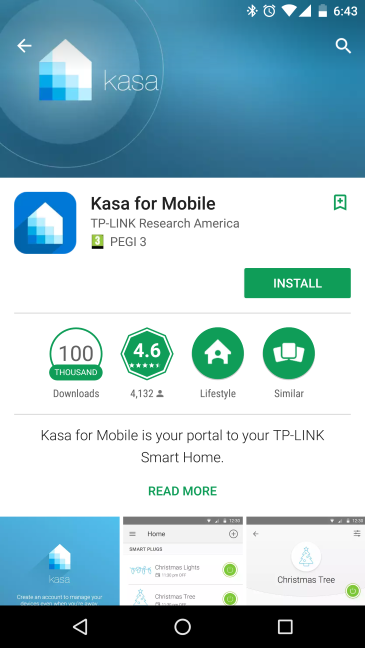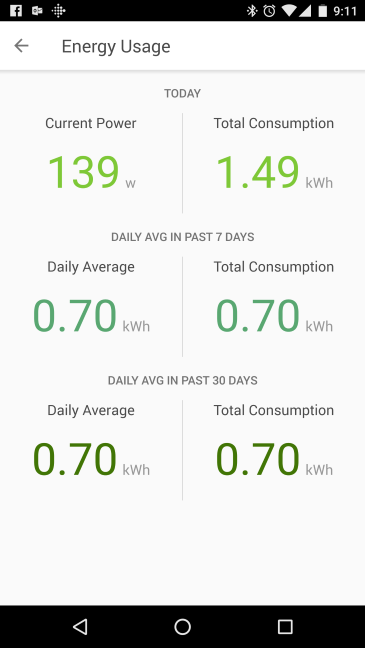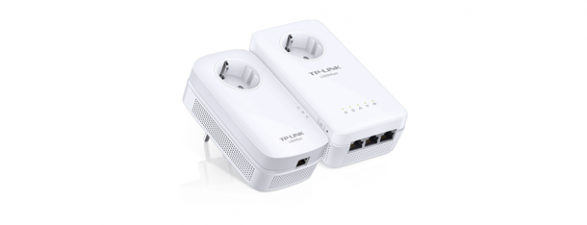
Would you like to have a plug that tells you how much electrical energy your devices consume? Do you want to turn off that plug from your smartphone, when you are not at home? Do you want it to simulate that you are at home, when you leave for a long time, by randomly turning on and off certain devices in your home, like your nightlight? If you do, then you should consider purchasing a smart plug or more. We recently got our hands on the TP-LINK HS110 smart plug and we tested it for about 10 days. Read this review to see our opinion about this device and whether it is worth purchasing for your smart home:
Unboxing the TP-LINK HS110 Wi-Fi Smart Plug
The TP-LINK HS110 Wi-Fi Smart Plug comes in a small white box, with a picture of the device on the top and the TP-LINK logo.
On the sides of the box, you will find information about this device and its hardware and software features. When you open the box, you will find the smart plug, the quick start guide, technical support information, the warranty and other leaflets.
The unboxing is quick, painless and overall, a pleasant experience. Now, let's see what this device has to offer in terms of specifications and features.
Hardware specifications and design
There are two parts to the specifications of this device: its hardware configuration and software ecosystem. First of all, let's speak about the hardware: the TP-LINK HS110 smart plug needs to connect to 2.4 GHz wireless networks in order to work as a smart device. It can connect to 802.11 b/g/n wireless networks but not to 802.11ac networks, which is a minus in our view. Smart homes need faster network connections, and supporting the 802.11ac would have been great.
TP-LINK HS110 can work well in temperatures varying from 32°F or 0ºC to 104°F or 40ºC, and a relative humidity between 5%~90%, making it suitable for most homes and offices. In terms of size, the plug is quite small, with 3.9 x 2.6 x 2.5 inches or 100.3 x 66.3 x 64 millimeters in height, width and depth. The total weight is only 4.34 ounces or 123.3 grams.
The smart plug has two buttons: one on the top for resetting it to its default configuration and the second button on the front. This one has a WiFi icon, which displays the connectivity, and an On/Off icon. You can press the second button to turn whatever's plugged into it On and Off.
In terms of software specifications, there is a lot more to talk about. First of all, the TP-LINK HS110 smart plug can be fully utilized only if you have a smartphone with Android or iOS. It can't be configured from PCs with Windows or any other operating system and there's no way to configure it from the web, even if you do have to connect it to the TP-LINK cloud, in order to configure it on your smartphone. On your smartphone, you must install the Kasa for Mobile app, made by TP-LINK. This app works with Android 4.1 or higher and iOS 8 or higher.
Once you configure the plug on your smartphone, you can schedule the working hours of the TP-LINK HS110, set the away mode, which simulates that someone is home while you are away from home and you can also control the smart plug with your voice, using Amazon Echo (if you have such a device at home).
To learn more about the official specifications of this device, go to this page: TP-LINK HS110 Specifications.
Setting up and using the TP-LINK HS110 Wi-Fi Smart Plug
The first step in setting up the TP-LINK HS110 is to plug into the electrical outlet where you want to use it. Then, plug the device(s) that you want to measure and control into the smart plug. However, before you can fully utilize it as a smart device, you need to install the Kasa for Mobile app for Android or iOS. With this app, you can connect to the smart plug, have it connected to your wireless network and configure the TP-LINK HS110 and all its features. If you don't install the app, TP-LINK HS110 will act as any other "dumb" plug. For our review, we used the app for Android, on a Nexus 6P smartphone with Android 7 installed.
One thing we noticed about the Kasa for Mobile app is that it requires access to many things, starting with your location, your files, wireless connection information as well as device ID and call information. This is quite a lot in our view and the app should require less access. Then, you must create an account on the TP-LINK cloud, in order to remote control your smart plug. Do this, verify your email account and then you can configure your smart TP-LINK devices, including the TP-LINK HS110.
With the Kasa for Mobile app, you can add and configure TP-LINK smart plugs, smart bulbs, mini plugs, smart switches and range extenders.
Once the Kasa for Mobile app detects the TP-LINK HS110 smart plug, you can set a name for it, an icon, and join it to your home's wireless network. After all these steps are done, you can see the status of the smart plug and activate and configure any of its features.
With the Kasa for Mobile app, you can set a schedule for the operation of the TP-LINK HS110 smart plug, you can enable the away mode and you can also set a timer for when to turn the smart plug on or off.
Unfortunately, there are conflicts between these modes. For example, the timer allows you to turn the smart plug on or off after a specified time and it will override the Away mode until the timer has been completed. Also, if there's a conflict between the schedule and timer, the smart plug will run based on whichever starts earlier. Therefore, when setting these features, make sure that they don't conflict with each other.
One thing I loved about TP-LINK's mobile app is the fact that it offers real-time statistics about the power that it is used by the device which is plugged into your smart plug and your total consumption. With it, I was able to learn how much my desktop PC consumes in terms of power.
You also get access to stats for the last 7 days and the last 30 days, which is great information to have. Couple all the live information you get, with the fact that you can remote control the smart plug when you are not at home, using your mobile data connection, and it's obvious that we are dealing with a very useful device and mobile app.
Getting back to the hardware, a minor negative about the TP-LINK HS110 smart plug is that you can't dim its light during the night, which might be annoying to some. It would have been nice to have this feature available for configuration, at least in the mobile app, if not a physical button for turning the lights off.
Overall, we are quite pleased by the TP-LINK HS110 Wi-Fi Smart Plug and what it has to offer. It's not perfect, especially not on the software side and we are only at the beginning of the smart home era. For a starting point, we are dealing with a device that's useful, easy to use and not very expensive. This is what matters most for most people.
The TP-LINK smart home cloud needs more security
While the TP-LINK HS110 smart plug is a great little device in itself, we do have some criticism TP-LINK's cloud-based ecosystem:
First of all, TP-LINK should offer access to configuring your smart home devices, in any web browser. The Kasa for Mobile app connects to TP-LINK's cloud and sends data to it, in order to offer remote control for all your smart home devices. However, if you open the same cloud in a web browser, by going to the TP-LINK Cloud website and authenticating with your account, there's nothing useful to be found. You are told that no camera exists in your account and that's it. You should be able to view and manage all your smart home devices on their website too.
Also, there's no Windows app available. Windows 10 is a big operating system and it's completely ignored by TP-LINK. If you have lost your smartphone, you are stuck!
Also, the security of TP-LINK's cloud is weak, to say the least. If someone hacks your smart home that's a huge deal. They can remote control your home and that's not a pleasant situation to be in. The TV Series Mr. Robot will give you a realistic idea of what can happen when someone hacks your smart home.
TP-LINK should implement as soon as possible minimum security features like two-step verification, and the possibility to set an additional PIN just for the Kasa for Mobile app so that someone stealing your smartphone can't also control your home. Working with a company that develops security products might be a great idea so that security is built into all of TP-LINK's smart home devices.
Pros and cons
The TP-LINK HS110 smart plug has many positives:
- It's not very expensive, even though its price is not for everyone
- It's small and light
- It's easy to use and setup
- You can remote control your smart plug even when you are not at home
- You can use it to save energy and lower your electricity bill
- You get real-time data about the energy consumption of the device(s) that you plug into the smart plug
There are also some negatives, not necessarily about the device itself, but mostly about the software and the cloud-based ecosystem created by TP-LINK for its smart home devices:
- It would be nice to be able to turn off the light on the TP-LINK HS110 smart plug, during the night
- There's no app for Windows and no website for remote controlling the TP-LINK HS110
- TP-LINK's cloud-based ecosystem lacks minimal security features like two-step verification and PIN protection for their mobile apps
- The timer, the scheduler, and the away mode can conflict with each other if you are not careful how you set them up
- The Android mobile app should require access to less information on your smartphone
Verdict
The TP-LINK HS110 smart plug is a very useful device and, if you can afford it, you will be happy with your purchase. It's easy to setup and use, and it offers data that you will find both informative and useful. Also, being able to remote control it when you are not at home is a great plus. However, you should keep in mind that we are at the beginning of the smart home era and, while there are many benefits to having a smart home, there are also a few important downsides, like the low security. TP-LINK's cloud platform needs many improvements in order to provide a smart home experience that's fun, useful and secure. While the company does a great job at the first two aspects of the smart home experience, they need to improve a lot on the third.


 21.02.2017
21.02.2017 












